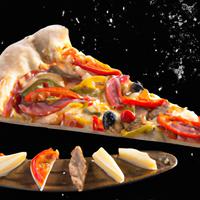
1 serving (150 grams) contains 285 calories, 12.0 grams of protein, 10.0 grams of fat, and 36.0 grams of carbohydrates.

Log this food in SnapCalorie

Nutrition Information
Calories |
452.4 | ||
|---|---|---|---|
% Daily Value* |
|||
| Total Fat | 15.9 g | 20% | |
| Saturated Fat | 7.1 g | 35% | |
| Polyunsaturated Fat | 0 g | ||
| Cholesterol | 31.7 mg | 10% | |
| Sodium | 1015.9 mg | 44% | |
| Total Carbohydrates | 57.1 g | 20% | |
| Dietary Fiber | 3.2 g | 11% | |
| Sugars | 6.3 g | ||
| protein | 19.0 g | 38% | |
| Vitamin D | 0 mcg | 0% | |
| Calcium | 317.5 mg | 24% | |
| Iron | 4.0 mg | 22% | |
| Potassium | 317.5 mg | 6% | |
* Percent Daily Values are based on a 2,000 calorie diet. Your daily values may be higher or lower depending on your calorie needs.
Food Attributes
Source of Calories
About Slice of pizza with mixed toppings
A slice of pizza with mixed toppings offers a satisfying combination of flavors and textures, inspired by Italian cuisine but enjoyed worldwide. Typically served on a baked crust, it is topped with tomato sauce, melted cheese, and an assortment of ingredients such as vegetables, meats, and herbs. Common toppings include bell peppers, mushrooms, onions, olives, pepperoni, sausage, and chicken. Nutritionally, vegetable toppings add fiber, vitamins, and minerals, while lean meats contribute protein. However, the cheese and processed meats can be high in saturated fats and sodium, making moderation key for balance. A whole-grain crust provides complex carbohydrates and additional fiber, making it a healthier option compared to refined flour bases. Despite its indulgent reputation, pizza can be customized to align with health goals—portion size and thoughtful toppings are crucial to maintaining its appeal as a delicious and versatile comfort food.



